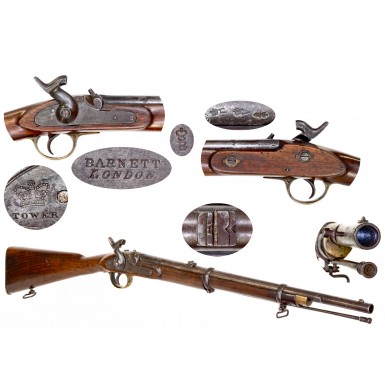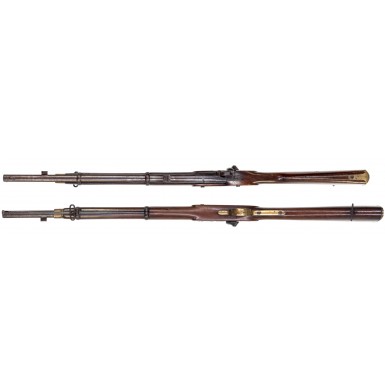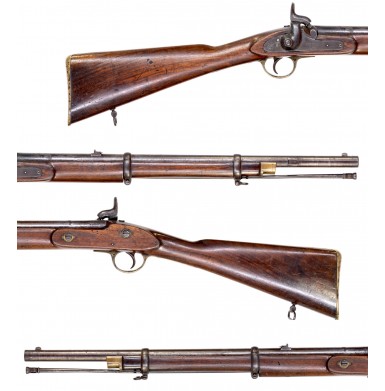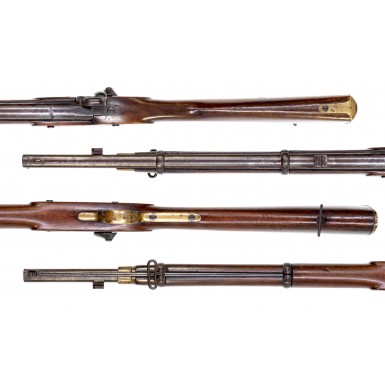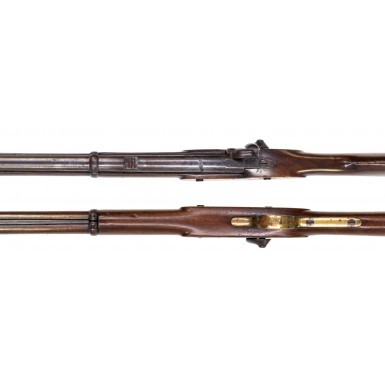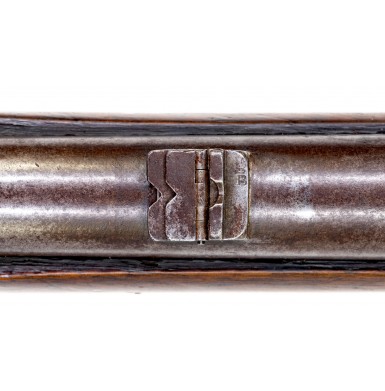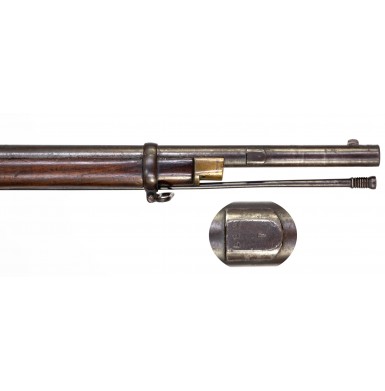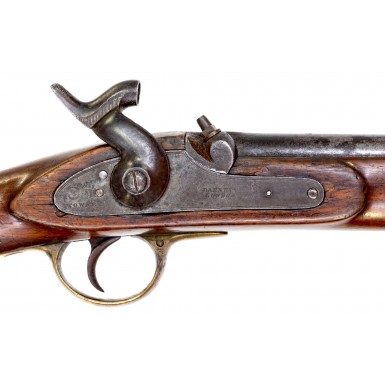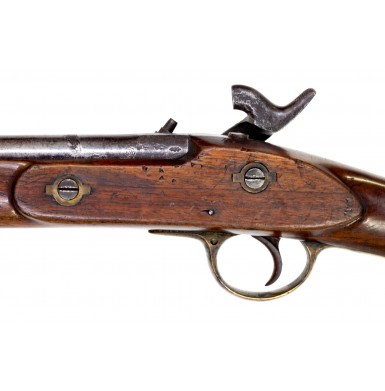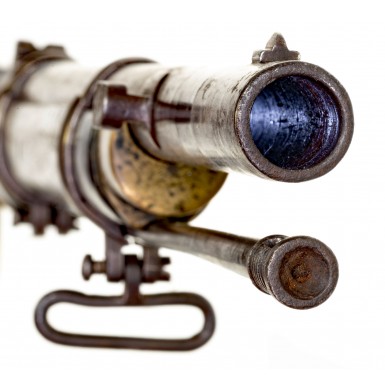Scarce Commercial Pattern 1853 Artillery Carbine by Barnett - A Likely Civil War Import Gun
- Product Code: FLA-4004-SOLD
- Availability: Out Of Stock
-
$2,995.00
The Pattern 1853 family of percussion long arms that started with the “Enfield” Rifle Musket gave rise to a variety of specialty long arms including the 21” barreled Pattern 1856 Cavalry Carbine with a captive rammer and the 24” barreled Artillery Carbine, in three variations – the Pattern 1853, Pattern 1853 Type II (aka Pattern 1858) and Pattern 1861. The Artillery carbines were intended for troops that might have the need for a long arm, rather than a pistol, but did not need to be encumbered with the weight and length of either the Pattern1853 rifle musket or any of the various Enfield short rifles, including the Patterns 1856, 1858, 1860 or 1861. It essentially served the same purpose for the British military during the 19th century as the M-1 carbine had for American troops during World War II and the Korean Conflict. As these guns were only intended for use by specialty troops in the British Army, they were produced in very small numbers and are not commonly encountered on the collector market today. During the American Civil War, these guns were imported by both sides, but in very small numbers when compared to the importation of rifle muskets and rifles, making Civil War used examples extremely scarce.
The Pattern 1853 Artillery Carbine was adopted by the British military in January 1853, with the initial contracts being let for it in October of that year. Like the rifle musket that it was patterned on, it was a .577 caliber, muzzle loading, percussion ignition long arm. The gun was brass mounted and was 40” in overall length. The 24” barrel was rifled with three grooves, making one turn in 78”, and had a bayonet lug mounted on the right side near the muzzle. The bayonet was a semi-Yataghan saber bayonet, of the same basic design as that used on the Pattern 1856/58/60/61 rifles. The bayonet for the Artillery carbine was the only one in British service at that time to utilize a metal scabbard, instead of the more commonly encountered iron mounted leather one. The carbine had a simple three-leaf rear sight, which was graduated to 100, 200 and 300 yards. A sling swivel was mounted on the upper of the two barrel bands, and one was screwed into the toe of the stock to the rear of the triggerguard tang. The first pattern carbines also utilized a semi-tulip head ramrod, similar to that found on Type I and early Type II Pattern 1853 Rifle Muskets. The primary pattern changes to the carbine occurred in 1858 and 1861. The new Pattern 1853 Type II Artillery Carbine (aka Pattern of 1858) adopted the progressive depth rifling system that had been used successfully on the Pattern 1853 Rifle Musket. At this time the ramrod was officially changed to the jag head pattern that had been adopted for the Pattern 1853 Rifle Musket as well. There were some other minor structural changes, including the removal of the short guide key on the bayonet lug, a design change in the rammer retention spoon, as well as the brass nose cap. All of this made the gun more like the current production Type III Rifle Musket. The final major innovations took the form of the Pattern 1861 Artillery Carbine, which did get an officially redesignated model year. This gun adopted the 5-groove rifling system, which had become standard on all short rifles in 1860 and also adopted a new rear sight, graduated to 600 yards. The new sight was now visually very similar to the rifle musket rear sight, with a long base and ladder with an elevating bar. The use of the rounded Baddeley Patent barrel bands was also adopted for the lower band of the Pattern 1861 carbines, with the upper band remaining a Palmer patent design as it held the sling swivel. There is no indication that any of the Pattern 1861 Artillery carbines were imported by either side during the American Civil War. All extant Civil War used examples are of the Pattern 1853 Type I or Type II, with some guns having features of both carbines, usually the Type II ramrod with earlier bayonet lug and rifling.
As previously noted, extant Civil War used Enfield artillery carbines are quite scarce, due to their limited purchase and importation by the combatants. US Ordnance documents indicate that somewhere between 480 and 730 were imported by the US for use, but it is difficult to determine for sure, as the language in the Ordnance descriptions is somewhat vague. Southern importation was significantly greater but was probably only around 4,500. These Confederate purchases have been established as a contract for 1,500 of the Artillery carbines, which were delivered in late 1861 and early 1862, as well as additional contracts from several sources that bring the total purchases to around 4,500. The early contract for 1,500 guns was marked like the 2nd Sinclair, Hamilton & Company contract Pattern 1853 Enfield rifle muskets, and the associated rifle contract. Those guns were marked with a JS / {ANCHOR} inspection mark behind the triggerguard and with an engraved inventory number on the buttplate tang and the ramrod shank. To only about 30 of these Confederate numbered artillery carbines are known to have survived. Birmingham contractors manufactured all of those numbered guns, except for a small block of about 40 that were provided by the London Armoury Company. The London Armoury guns are the early, Type I pattern with the extended guide bar on the bayonet lug and standard (non-progressive depth) rifling, but with the later Type II jag head ramrod. The majority of the other numbered guns appear to have been provided by the furnisher W.C. Scott & Son, and the extant examples of guns numbered from abut 400 and up have the S furnishers mark of Scott & Son on the comb of the stock.
Other than these 1,500 JS/Anchor marked and inventory numbered guns, some additional 3,000 carbines appear to have been purchased. Some were purchased from English arms speculator William Grazebrook, and at least 220 artillery carbines are listed in the inventory of the blockade runner Fingal, which made its delivery of arms into the port of Savannah, GA on November 14, 1861. Additional carbines were listed in the inventories of the Confederate blockade runners Stephen Hart (captured and believed to be part of the original order of 1,500 numbered guns) and Harriett Pickney. Between 1863 and 1864, some additional 3,400 “artillery carbines” were delivered into the port of Wilmington, NC by a variety of Confederate blockade runners. However it not completely clear what pattern these guns were, as some could have been Austrian artillery carbines as well. The Pattern 1853 Artillery Carbine was particularly popular with Confederate General J.E.B. Stuart, the commander of the Army of Northern Virginia’s cavalry corps. A 7 October 1862 missive from Stuart states in part:
“Application from General Stuart, commanding cavalry, to exchange rifles, for the Enfield carbines (artillery) in the hands of our infantry.”
This not only indicates Stuart’s preference for the short-barreled arm, but also indicates that some of these guns were seeing service in the ranks of Confederate infantry around the time of the battle of Antietam (Sharpsburg). The fact that it accepted a saber bayonet of the same pattern as the Pattern 1856/58/60 rifles made it a handy weapon for light infantry.
The British Pattern 1853 Enfield Artillery Carbine offered here is the 2nd pattern, a Pattern 1853 Type II which is sometimes referred to as the Pattern 1858 Artillery Carbine and is in VERY GOOD+ condition overall. The gun is essentially 100% complete, correct and original, which is quite rare to encounter with this pattern of carbine. The gun retains the original and correct multi-leaf rear sight, both original sling swivels and both of the small screw retaining doughnut protectors on the barrel band screws. The gun does not have the usual leather and iron snap cap & chain (nipple protector), nor does is have the hole forward of the trigger guard to mount the stud it would have been attached to. Apparently Barnett omitted that feature on this gun, possibly as a cost saving measure or as a manufacturing shortcut to save time. The triggerguard used for the carbine is a Pattern 1853 rifle musket style guard, which has detents for drilling the hole that mounted the sling swivel, however this hole was never drilled as it was unnecessary. Barnett may have been using up some spare parts when they built this gun. The original saber bayonet lug is present on the gun and is numbered 1 / 337 to match it to the bayonet that had been fit to it. The ramrod is the original, correct rod and is full length, complete with threads and bears a strong T&CG (Thomas & Charles Gilbert) makers mark on the shaft. The rod is also marked near the tip with the same 1 found on the bayonet lug, and the rear of the rod (near the threads) is marked with four file slashes: \ | | |. These same file slashes are found throughout the gun as assembly marks. The gun is clearly marked at the breech with the typical London commercial proofs, but without a gauge mark. The lock plate has the usual {CROWN} to the rear of the hammer, and this mark surmounts the word TOWER, a marking that is occasionally seen on Barnett produced guns that saw Confederate use. It is my favorite Barnett lock marking and in my opinion is an early wartime marking. The lock is further marked BARNETT / LONDON forward of the hammer as well as with a small {CROWN} / B, which was the Barnett trademark. This same mark is also present in on the top of the base of the rear sight and in the wood behind the triggerguard, in the belly of the stock. The interior of the lock is marked by its maker T TURNER(Thomas Turner) over a large A and is also stamped BARNETT. The upper edge of the lock plate is marked with the same file slash assembly marks already mentioned on the ramrod and with a W W. This same W W mark is also present on the tail of the counterpane opposite the lock and under the barrel. In the wood of the stock under the triggerguard is the mark W WILLIAMS. This implies that Williams was “WW” and was the setter up (final assembler & fitter) of the gun. The bottom of the barrel is additionally marked with a faint GUN BARREL CO mark, which has been over stamped BARNETT. The bottom of the breech and the breech plug are both marked 13 and a large A, just like the one inside the lock. The ramrod channel is marked with the four-slash mating mark \ | | | as well as MURPHY, who was likely the stock maker. The firm of J.E. Barnett & Sons was a famous London based gunmaking firm. The Barnett’s were a family that traced their arms making heritage to Thomas Barnett who established the family business in London in 1796. During the Civil War era, Barnett was located Brewhouse Lane, Wapping (1860-1874).
As previously noted, the overall condition of the gun is VERY GOOD+. The fit and finish of the gun are very nice and the wood to metal fit is particularly crisp. The action of the lock works perfectly and remains quite crisp and tight. The metal of the gun is moderately oxidized with a somewhat mottled combination of a dark gray and chocolate brown patina over a dull pewter gray base metal. The lock has a mottle gray and brown patina that also shows some dulled hints of the original case colored finish. The metal is mostly smooth with scattered surface roughness, some light peppering and pinpricking present, and some areas of pitting that are mostly confined to the breech area and near the muzzle. The bore rates about FAIR at best and is heavily oxidized and pitted with only the weakest traces of rifling part way down the barrel. The stock is in VERY GOOD+ overall condition and is complete and solid with no breaks or repairs. The stock retains very nice edges and is fairly crisp throughout. There are some small, splintered chips missing around the lock mortise, the result of the lock being improperly removed at some time in the past. There are also a number of bumps, ding, scratches, and bruises on the stock, all of which is normal wear and tear for a military long arm. There are also a couple couple of small grain surface cracks present, most notably the one at the tail of the lock mortise, that are mentioned for exactness but are in no way structural or in any way detract from display.
Overall, this is a really attractive example of one of the least often encountered British import arms of the American Civil War. When these guns are found they are often missing the rear sight or at least the sight leaves, and other small parts like the toe mounted sling swivel. Finding a complete gun is almost impossible. While the gun carries no Confederate import marks it is almost certainly a Confederate purchased gun. The T&CG marked ramrod places the production of the gun prior to the end of 1862 (Thomas & Charles Gilbert went out of business in 1862). It appears that Confederate purchasing agents contracted for the large majority of Barnett’s production output in 1861 & 1862. Today Barnett Enfields from the Civil War can be found with both Confederate Central Government and Confederate State import and ownership marks. In some cases when the CS state markings are found, no other CS mark is noted. With Barnett’s limited output when compared to a fully industrialized manufacturer like the London Armoury Company and the Confederacy’s intense need for arms, it is very reasonable to assume that nearly all of Barnett’s commercial output for the first two years of the war went to fill southern contracts. The condition is simply wonderfully used, but well cared for, with only the bore a true disappointment. It is not a gun that was never issued, nor is it one that saw abusive service. It is simply a solid example of a real military-used artillery carbine that you will never have to make any excuses for. These guns are quite scarce, and I am always looking for them to buy. This is a gun that any import arms collector will be very happy to add to their collection and will no doubt enjoy for many years to come.
SOLD
Tags: Scarce, Commercial, Pattern, 1853, Artillery, Carbine, by, Barnett, A, Likely, Civil, War, Import, Gun

